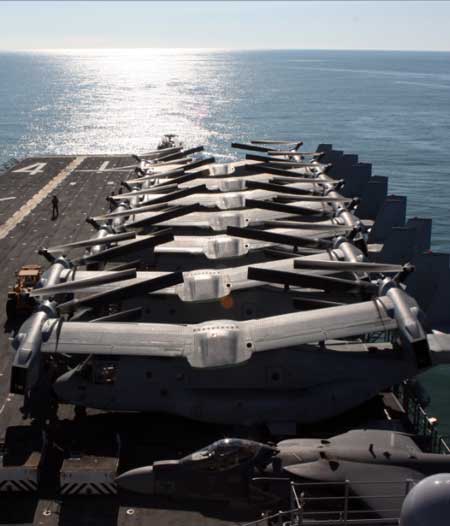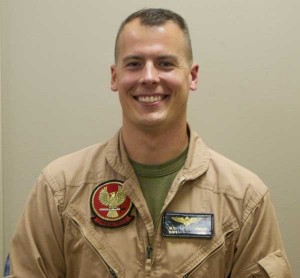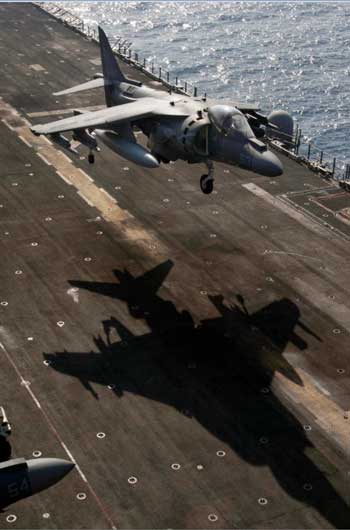New River Update on the Osprey: Osprey Speed and Range Enables Change
10/08/2010 – In an SLD interview with Captain Dwyer, the Osprey pilot discussed his time with the MEU after leaving Haiti. The USS Nassau on which Captain Dwyer was deployed first went to Haiti (which will be discussed next week) and then left for the Gulf of Aden after the Haiti engagement. During his time on board the USS Nassau, the Marine Expeditionary Group executed some new tactical opportunities associated with the use of the Osprey. The speed of the Osprey allows it to work more effectively with fast jets, which allowed the commander to split the MEU into a rotorcraft supported fleet and a fast jet and Osprey supported fleet. By splitting the MEU, the commander gains significant operational flexibility, but without loss of the integrity for the operation. This provides a solid bedrock in preparation for the inclusion of the F-35B with the fleet, anticipating a time when the Osprey and F-35B operate together, enabling the three dimensional warrior.
Captain Dwyer: After Haiti, we started heading east and we went to the Gulf of Aden and from there, we were operating out of Djibouti. We actually split the MEU, the entire MEU, which I don’t believe, had been done before in specific type model series, so all of the skids, the Hueys and Cobras were on one ship and they were almost autonomous. They pretty much got to do different things than the ones they were scheduled to do with different countries under the umbrella of the 24th MEU, but didn’t impact our actual operations. The 53s, that are grounded in Djibouti, hopped off the Nassau as soon as we got in there, so it was really an AV-8 and V-22 show for four and a half to five months.
SLD: Because you have operated solely flying the Osprey, you come at the question of the potentials with a fresh eye. Is this an opportunity to shape a new relationship with fast jets and to re-shape con-ops?
Captain Dwyer: I saw so much potential for the short take-off vertical landing attack aircraft, fixed-wing aircraft and the V-22 working together. In the future, I would have those two, the V-22 and F-35 working very closely together and even for extended operations when you add the refueling piece. The paring of these two aircraft are far better than paring the V-22 with any of the helicopters.
I saw so much potential for the short take-off vertical landing attack aircraft, fixed-wing aircraft and the V-22 working together. In the future, I would have those two, the V-22 and F-35 working very closely together and even for extended operations when you add the refueling piece. The paring of these two aircraft are far better than paring the V-22 with any of the helicopters.
SLD: Is it because of speed?
Captain Dwyer: Because of speed, range. And not only that. It’s the endurance of the aircraft itself. Basically you might say once it’s flying, it’s flying. And we had a lot of missions that required flight time above six hours, which is very taxing for the jet guys and for us, it is as well, but maybe not so bad because we can trade off in the cockpit. The fact is that you can have airborne assets, both as a package as well as a trap for sensitive site exploitations, being airborne all at the same time for hours at a time to respond to something that happens in the AOR. It will give you the maximum flexibility for response time down to something like thirty minutes, depending on where it is. And then sanitize the scene from there and then everybody returns home. It’s a capability that I’m not going to say it’s been overlooked but it just hasn’t been utilized like that.
SLD: This provides the capability to insert and withdraw force both airborne and ground insertion.
Captain Dwyer: We just didn’t really have that capability before, especially on much longer ranges and in sort of response time. So by marrying those two, the fixed-wing aviation asset we can do operations differently. We could neutralize a target and then you can immediately have a strike team insert to confirm that whatever happen, happened, give whatever materials they need, get back on an aircraft and leave in under thirty minutes in any location that we’re operating on a 600-mile ring. This is just so amazing for me.
SLD: What changes to the ships would you make to facilitate Osprey ops?
Captain Dwyer: A bigger hangar. We would be big enough so that the V-22 could do a full range of maintenance inside the hangar.
SLD: What is the impact of replacing the F-35B with the Harrier?
Captain Dwyer: When you separate the V-22 and the fixed-wing striker you untether the range from the helicopters. So since we could put the V-22/F35B tandem on a different vessel, that vessel can go somewhere else and still be able to provide protection for the entire MEU because of speed, range and capabilities.
When you separate the V-22 and the fixed-wing striker you untether the range from the helicopters. So since we could put the V-22/F35B tandem on a different vessel, that vessel can go somewhere else and still be able to provide protection for the entire MEU because of speed, range and capabilities.
SLD: On another ship?
Captain Dwyer: On a different ship. We don’t have to accompany them at close range to provide support.
 Ospreys from Marine Medium Tilt Rotor Squadron 162 (Reinforced),
Ospreys from Marine Medium Tilt Rotor Squadron 162 (Reinforced),
24th Marine Expeditionary Unit, quietly remain full stowed on the flight deck of USS Nassau
on January 19th, 2010 for their upcoming deployment
Credit photo: USN Visual Service, 1/21/10
SLD: So you would be supporting them, but at much greater range.
Captain Dwyer: Absolutely, or not only could we be supporting them but we could be supporting someone else at the same time that’s much farther away. The AV-8 or the F-35 and the V-22 give you great range. We have the opportunity, especially throughout the Mediterranean and also in the Middle East where you can take detachments from each of the squadrons or from each of those aircrafts to take some F-35s, take a couple of V-22s, put them on an airfield somewhere and support those separately. You’re not restricted to space yet you have the range to do other things and support those other smaller ships.



